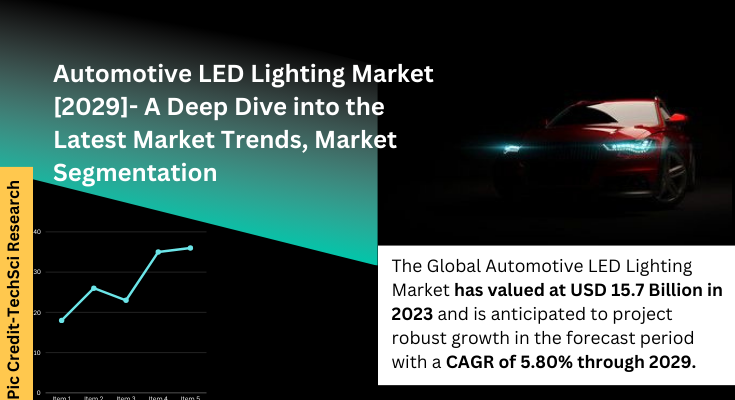According to TechSci Research report, “Global Automotive LED Lighting Market – Industry Size, Share, Trends, Competition Forecast & Opportunities, 2029”, the Global Automotive LED Lighting Market stood at USD 15.7 Billion in 2023 and is anticipated to grow with a CAGR of 5.8% in the forecast period, 2025-2029. The global automotive LED lighting market is witnessing remarkable growth due to various factors. Technological advancements, such as the development of advanced lighting solutions, are driving the market forward. Moreover, the increasing consumer demand for energy-efficient and high-performance lighting options has further fueled the market’s expansion. Additionally, the rise in automobile production, coupled with strict government regulations for enhanced vehicle safety, has contributed to the market’s steady growth. These factors collectively highlight the significant potential and promising future prospects for the automotive LED lighting industry.
LEDs, renowned for their exceptional durability, remarkable energy efficiency, and impressively extended lifespan, are rapidly supplanting conventional lighting systems in vehicles. The adoption of these cutting-edge lights in exterior lighting applications, including headlights, tail lights, and turn signals, is steadily increasing. With their superior visibility, LEDs substantially diminish the risk of accidents, ensuring enhanced safety on the road.
In addition, manufacturers are heavily investing in R&D activities to develop innovative lighting solutions that offer dynamic functions and enhance aesthetic appeal. These advancements are expected to provide lucrative opportunities for the growth of the LED automotive lighting market.
Regionally, Asia Pacific leads in terms of market share, followed by North America and Europe. The Asia Pacific market growth is driven by the presence of major automobile manufacturers, increasing vehicle production, and rising adoption of LEDs in vehicles. In contrast, the North American and European markets are influenced by strict regulations regarding vehicle lighting and safety.
Furthermore, the increasing trend of electric and autonomous vehicles is having a significant positive impact on the market. As environmental concerns continue to rise and the emphasis on reducing carbon emissions becomes more pronounced, the demand for electric vehicles is experiencing remarkable growth. This surge in demand, in turn, is driving the need for energy-efficient automotive LEDs to cater to the specific requirements of electric vehicles and ensure optimal performance while minimizing energy consumption. By embracing energy-efficient automotive LEDs, the automotive industry is taking a pivotal step towards sustainability and eco-friendly transportation solutions.
However, the market also faces some challenges like the high cost of LED lights and lack of standardization, which can hinder its growth. Nonetheless, the overall outlook for the global automotive LED lighting market remains favorable, with a steady growth trajectory anticipated over the forecast period.
Browse over market data Figures spread through 180 Pages and an in-depth TOC on the “Global Automotive LED Lighting Market” @ https://www.techsciresearch.com/report/automotive-led-lighting-market/22014.html
The Global Automotive LED Lighting Market is undergoing a transformative evolution, driven by technological advancements, changing consumer preferences, and the automotive industry’s commitment to innovation. LED (Light Emitting Diode) technology has emerged as a key player in the automotive lighting sector, revolutionizing both interior and exterior lighting systems in vehicles.
One of the defining trends in the automotive LED lighting market is the increasing adoption of advanced lighting features. Automotive manufacturers are leveraging LED technology to introduce innovative lighting solutions that go beyond conventional illumination. Adaptive lighting systems, matrix beam headlights, and dynamic turn signals are becoming standard features in modern vehicles. These advanced features not only contribute to improved road safety but also cater to consumer preferences for sophisticated and dynamic lighting solutions, driving the demand for LED technology.
The integration of LEDs is not confined to traditional applications like headlights and taillights; it has expanded to include interior lighting, ambient lighting, and other decorative elements. LED technology allows for customizable cabin illumination, creating a visually appealing and immersive driving environment. Interior LED lighting is now a crucial aspect of vehicle design, offering automakers the flexibility to enhance the overall aesthetics and user experience within the vehicle cabin. On the exterior, LEDs power daytime running lights (DRLs), brake lights, and turn signals, showcasing the versatility of LED lighting solutions in both functional and aesthetic aspects of vehicle design.
The rise of electric vehicles (EVs) and the development of autonomous driving technologies are influencing the trajectory of the automotive LED lighting market. Electric vehicles, with their emphasis on energy efficiency, align seamlessly with the benefits offered by LED lighting. The low power consumption of LEDs contributes to extending the driving range of electric vehicles while providing bright and efficient lighting solutions. In parallel, the evolution toward autonomous vehicles has heightened the importance of sophisticated lighting systems. LEDs, with their rapid response time and dynamic control capabilities, play a crucial role in creating intuitive communication through lighting, facilitating safer interactions between autonomous vehicles, pedestrians, and other road users.
Sustainability has become a growing emphasis in the automotive LED lighting market. LED technology inherently aligns with sustainability goals due to its energy efficiency and longer lifespan. As the automotive industry faces increasing pressure to reduce its environmental footprint, LED lighting solutions contribute to energy conservation and overall eco-friendliness. Manufacturers are exploring sustainable materials for LED components, incorporating recyclable materials and environmentally friendly manufacturing processes. The emphasis on sustainability extends to end-of-life considerations, promoting recyclability and responsible disposal practices for LED components. As eco-consciousness becomes a defining factor in consumer choices, the automotive industry is leveraging LED technology to demonstrate its commitment to sustainable practices.
Customization and brand differentiation through LED lighting have emerged as a notable trend in the Global Automotive LED Lighting Market. LED technology allows for a high degree of customization in terms of color, intensity, and sequencing. Automotive manufacturers are capitalizing on this flexibility to create signature lighting designs that align with their brand identities. Distinctive lighting signatures in headlights and taillights serve as a visual identifier for various automotive brands, enhancing brand recognition and differentiation. This trend is particularly evident in premium and luxury vehicle segments, where unique lighting designs contribute to the overall luxury and sophistication of the vehicle. As consumers increasingly prioritize personalization and brand affinity, LED lighting serves as a powerful tool for automakers to create memorable and recognizable visual identities.
While these trends drive innovation and demand in the automotive LED lighting market, there are notable challenges that industry participants must navigate. The initial high cost associated with LED technology remains a significant challenge. Despite advancements that have reduced manufacturing costs, the upfront investment required for LED systems is still relatively higher than traditional lighting technologies. Striking a balance between affordability and the benefits of LED technology is crucial for market penetration and broader consumer adoption, requiring manufacturers to explore cost-effective production methods and economies of scale.
Technological complexity and integration challenges pose additional hurdles for the automotive LED lighting market. The intricate electronics, thermal management systems, and control units required for optimal LED performance demand expertise in electronics and software integration. The integration of advanced features such as adaptive lighting and dynamic turn signals adds to the complexity, necessitating seamless coordination with other vehicle electronics and safety systems. Overcoming these challenges requires continuous innovation, collaboration among industry stakeholders, and efforts to enhance the compatibility and integration of LED technology into diverse vehicle architectures.
Heat management and durability concerns represent persistent challenges in the automotive LED lighting market. LED technology, while efficient, generates heat during operation, and effective heat dissipation is crucial for maintaining performance and longevity. The compact spaces within automotive lighting assemblies pose challenges in managing heat effectively, and failure to address heat-related issues can lead to premature LED degradation. Furthermore, external factors such as extreme temperatures, moisture, and vibrations in diverse driving conditions can impact the durability of LED lighting systems. Ensuring the resilience of LEDs to environmental stressors and developing effective heat dissipation solutions are essential for meeting the stringent performance and reliability expectations in the automotive industry.
Standardization and compatibility across models present another challenge for the Global Automotive LED Lighting Market. The lack of standardized regulations and specifications for LED lighting in vehicles complicates the development of universal standards. The diverse range of LED features, designs, and configurations makes it challenging to ensure compatibility across different vehicle models and brands. Achieving uniformity in LED lighting specifications would facilitate smoother integration, promote interoperability, and enhance consumer confidence in the reliability and safety of LED lighting systems.
Lastly, consumer awareness and education are critical challenges for the automotive LED lighting market. While LED technology offers numerous benefits, including energy efficiency, longer lifespan, and enhanced safety features, consumer understanding of these advantages may vary. Educating consumers about the benefits of LED lighting, including its impact on fuel efficiency, reduced carbon emissions, and enhanced visibility, is essential for fostering broader adoption. Manufacturers and industry stakeholders face the challenge of effectively communicating the value proposition of LED technology to consumers, dispelling misconceptions, and highlighting the long-term cost savings and environmental benefits associated with LED lighting systems.
In conclusion, the Global Automotive LED Lighting Market is witnessing a dynamic interplay of trends and challenges as it navigates the path of innovation, sustainability, and consumer-driven customization. The increasing adoption of advanced lighting features, integration of LEDs in interior and exterior applications, the rise of electric and autonomous vehicles, the growing emphasis on sustainability, and the trend of customization and brand differentiation collectively shape the landscape of automotive lighting. As industry participants address challenges and capitalize on trends, the automotive LED lighting market is poised to play a pivotal role in defining the future of vehicle lighting solutions.
Major companies operating in the Global Automotive LED Lighting Market are:
- OSRAM Licht AG
- HELLA KGaA Hueck & Co
- Koito Manufacturing Co., Ltd
- Stanley Electric Co.Ltd
- Koninklijke Philips N.V.
- Valeo SA
- Imasen Electric Industrial Co., Ltd.
- Texas Instruments
- Nichia Corporation
- General Electric Company
To Download FREE Sample Pages of this Report📥 @ https://www.techsciresearch.com/sample-report.aspx?cid=22014
Customers can also request for 10% free customization on this report.
“The Global Automotive LED Lighting Market is experiencing a revolutionary shift, driven by technological advancements and changing industry dynamics. LED technology has become the cornerstone of automotive lighting, offering enhanced safety, energy efficiency, and design flexibility. As manufacturers increasingly adopt advanced features like adaptive lighting and customizable interior illumination, the market is witnessing a surge in demand. The rise of electric and autonomous vehicles further accentuates the pivotal role of LEDs in modern automotive design. With a growing emphasis on sustainability and brand differentiation, the automotive LED lighting market stands at the forefront of innovation, shaping the future of vehicle illumination globally.” said Mr. Karan Chechi, Research Director with TechSci Research, a research-based management consulting firm.
“Automotive LED Lighting Market – Global Industry Size, Share, Trends, Opportunity, and Forecast, Segmented By Position (Front, Rear, Side and Interior), By Vehicle Type (Passenger Cars, Commercial Vehicles), By Adaptive Lighting (Front Adaptive Lighting, Rear Adaptive Lighting and Ambient Adaptive Lighting), By Region, Competition, 2019-2029”, has evaluated the future growth potential of Global Automotive LED Lighting Market and provides statistics & information on market size, structure, and future market growth. The report intends to provide cutting-edge market intelligence and help decision-makers make sound investment decisions. Besides, the report also identifies and analyzes the emerging trends along with essential drivers, challenges, and opportunities in the Global Automotive LED Lighting Market.
You may also read:
Electric Vehicle Fast Charging System Market – Trends, Share [Latest] & Forecast
Automotive Fuel Filter Market | [Latest] Exploring Market Growth, Potential, Trends
Light Commercial Vehicle Telematics Market Advancements and Business Opportunities [2029]
Table of Content-Automotive LED Lighting Market
- Introduction
1.1. Product Overview
1.2. Key Highlights of the Report
1.3. Market Coverage
1.4. Market Segments Covered
1.5. Research Tenure Considered
- Research Methodology
2.1. Objective of the Study
2.2. Baseline Methodology
2.3. Key Industry Partners
2.4. Major Association and Secondary Sources
2.5. Forecasting Methodology
2.6. Data Triangulation & Validation
2.7. Assumptions and Limitations
- Executive Summary
3.1. Market Overview
3.2. Market Forecast
3.3. Key Regions
3.4. Key Segments
- Impact of COVID-19 on Global Automotive LED Lighting Market
- Global Automotive LED Lighting Market Outlook
5.1. Market Size & Forecast
5.1.1. By Value
5.2. Market Share & Forecast
5.2.1. By Position Market Share Analysis (Front, Rear, Side and Interior)
5.2.2. By Vehicle Type Market Share Analysis (Passenger Cars, Commercial Vehicles)
5.2.3. By Adaptive Lighting Market Share Analysis (Front Adaptive Lighting, Rear Adaptive Lighting and Ambient Adaptive Lighting)
5.2.4. By Regional Market Share Analysis
5.2.4.1. Asia-Pacific Market Share Analysis
5.2.4.2. Europe & CIS Market Share Analysis
5.2.4.3. North America Market Share Analysis
5.2.4.4. South America Market Share Analysis
5.2.4.5. Middle East & Africa Market Share Analysis
5.2.5. By Company Market Share Analysis (Top 5 Companies, Others – By Value, 2023)
5.3. Global Automotive LED Lighting Market Mapping & Opportunity Assessment
5.3.1. By Position Market Mapping & Opportunity Assessment
5.3.2. By Vehicle Type Market Mapping & Opportunity Assessment
5.3.3. By Adaptive Lighting Market Mapping & Opportunity Assessment
5.3.4. By Regional Market Mapping & Opportunity Assessment
- Asia-Pacific Automotive LED Lighting Market Outlook
6.1. Market Size & Forecast
6.1.1. By Value
6.2. Market Share & Forecast
6.2.1. By Position Market Share Analysis
6.2.2. By Vehicle Type Market Share Analysis
6.2.3. By Adaptive Lighting Market Share Analysis
6.2.4. By Country Market Share Analysis
6.2.4.1. China Market Share Analysis
6.2.4.2. India Market Share Analysis
6.2.4.3. Japan Market Share Analysis
6.2.4.4. Indonesia Market Share Analysis
6.2.4.5. Thailand Market Share Analysis
6.2.4.6. South Korea Market Share Analysis
6.2.4.7. Australia Market Share Analysis
6.2.4.8. Rest of Asia-Pacific Market Share Analysis
6.3. Asia-Pacific: Country Analysis
6.3.1. China Automotive LED Lighting Market Outlook
6.3.1.1. Market Size & Forecast
6.3.1.1.1. By Value
6.3.1.2. Market Share & Forecast
6.3.1.2.1. By Position Market Share Analysis
6.3.1.2.2. By Vehicle Type Market Share Analysis
6.3.1.2.3. By Adaptive Lighting Market Share Analysis
6.3.2. India Automotive LED Lighting Market Outlook
6.3.2.1. Market Size & Forecast
6.3.2.1.1. By Value
6.3.2.2. Market Share & Forecast
6.3.2.2.1. By Position Market Share Analysis
6.3.2.2.2. By Vehicle Type Market Share Analysis
6.3.2.2.3. By Adaptive Lighting Market Share Analysis
6.3.3. Japan Automotive LED Lighting Market Outlook
6.3.3.1. Market Size & Forecast
6.3.3.1.1. By Value
6.3.3.2. Market Share & Forecast
6.3.3.2.1. By Position Market Share Analysis
6.3.3.2.2. By Vehicle Type Market Share Analysis
6.3.3.2.3. By Adaptive Lighting Market Share Analysis
6.3.4. Indonesia Automotive LED Lighting Market Outlook
6.3.4.1. Market Size & Forecast
6.3.4.1.1. By Value
6.3.4.2. Market Share & Forecast
6.3.4.2.1. By Position Market Share Analysis
6.3.4.2.2. By Vehicle Type Market Share Analysis
6.3.4.2.3. By Adaptive Lighting Market Share Analysis
6.3.5. Thailand Automotive LED Lighting Market Outlook
6.3.5.1. Market Size & Forecast
6.3.5.1.1. By Value
6.3.5.2. Market Share & Forecast
6.3.5.2.1. By Position Market Share Analysis
6.3.5.2.2. By Vehicle Type Market Share Analysis
6.3.5.2.3. By Adaptive Lighting Market Share Analysis
6.3.6. South Korea Automotive LED Lighting Market Outlook
6.3.6.1. Market Size & Forecast
6.3.6.1.1. By Value
6.3.6.2. Market Share & Forecast
6.3.6.2.1. By Position Market Share Analysis
6.3.6.2.2. By Vehicle Type Market Share Analysis
6.3.6.2.3. By Adaptive Lighting Market Share Analysis
6.3.7. Australia Automotive LED Lighting Market Outlook
6.3.7.1. Market Size & Forecast
6.3.7.1.1. By Value
6.3.7.2. Market Share & Forecast
6.3.7.2.1. By Position Market Share Analysis
6.3.7.2.2. By Vehicle Type Market Share Analysis
6.3.7.2.3. By Adaptive Lighting Market Share Analysis



